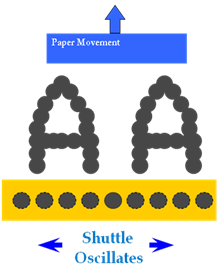Dot matrix printer
A matrix printer generates its print image by setting individual small pixels. Unlike z. B. a character wheel printer , a matrix printer is therefore not limited to a fixed set of characters , but can print any font and graphics. The term is rarely used as a differentiating criterion, as there are practically no other methods for computer printing today.
Definition
The term matrix printer ( Latin mater : mother, creator, source or origin; in mathematics or physics mostly used for the arrangement or structuring of elements, objects, etc.) can be precisely defined in terms of linguistics or technology, but the use of the term often deviates from it from. The term was often used until the 1980s to differentiate these graphics-compatible and almost universally usable computer printers from conventional printing units. Traditionally, the usual letter printing was usually done on a type wheel or ball-head typewriter. Print wheel printers , which were previously valued in offices for the high quality of correspondence, were expensive top models. Drawing devices like the plotter were specialized niche products. The term non-matrix printer, as opposed to matrix printer, did not find its way into linguistic usage.
Sometimes only dot matrix printers (and also the earlier low-resolution inkjet printers ) are synonymous with matrix printers because of their clearly visible dot matrix. However, this synonym usage is incorrect. Matrix printing refers to any kind of printing process in which characters, graphics and other elements are formed in the form of a dot matrix, which is the case with practically all printers commercially available today.
Working principle

The following explains printing methods that are commonly referred to as dot matrix printers. They are an example of the general principle of the matrix printing process.
This mainly affects the following printer types:
- Dot matrix printers and the line and page printers that work on the same principle
- Ink printers and the plotters working with ink printers
- Thermal printers (mainly the most widely used direct thermal printers )
- Partly also the laser printer and some other printing processes.
pressure
The matrix printer composes its image from individual points. For this purpose, in the case of the needle and ink jet printer, the printer has a print head on a movable carriage that is moved horizontally across the paper. The printhead has several needles or ink nozzles that can print point by point on the paper. In this way, the printed image is put together piece by piece. With regard to the horizontal movements of the print head, there are three different types:
- unidirectional printing: the print head only prints on the way out of its rest position and moves back again to print the next line after a line feed,
- bidirectional printing: the print head prints both on its way there and on its way back,
- Bidirectional printing with print path optimization : the printhead does not move over the entire horizontal printable area, but only so far that the next line can be completely printed.
In a laser printer , the charge on a drum is changed by means of a laser : toner particles may or may not stick to the drum and are transferred to the paper. The print head of a laser printer does not consist of individual dots, but here, too, the smallest unit is determined by a pixel.
Control
The type wheel printer only needs to be told where which character is to be printed. This is different with the matrix printer, in which every single pixel can be controlled - this of course also increases the amount of data that the computer has to provide and transfer.
But since it can be in practice that the printing of texts in relation to the dominant graphics, matrix printers usually have a selection of typefaces built in. In this case, the printer only needs to be told which typeface to use and which character to print from it, with the final processing of the character being done by the printer.
colourfulness
Whether a matrix printer can print in color depends on the printing process used and e.g. B. the thermal printer depends on the paper.
With laser printers, four printing units in the primary printing colors black, cyan (turquoise), magenta (purple) and yellow are normally used in parallel in one operation; with inkjet printers, it depends on the model whether a multi-color combination cartridge or the three mixed colors are used separately in addition to the black cartridge become. Almost all other colors (except for spot colors ) can be mixed from them by means of subtractive color mixing .
Depending on the device support, multi-colored ribbons were available for dot matrix printers, but - as with typewriter ribbons - they have almost completely disappeared from the market. Form paper with multiple color zones for thermal printing is also rarely used for cost reasons. In these niche applications, printing is almost exclusively done in black (monochrome). However, multi-colored color foils in thermal transfer printing are still used for printing in small series.
advantages and disadvantages
The advantages of the matrix printer lie in its flexibility and graphic capability. In the past, however, the print quality was a disadvantage: while a print wheel printer offered the usual clear typeface of a typewriter , individual pixels were recognizable when printing out from 8-pin printers.

